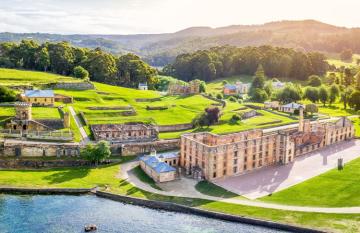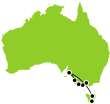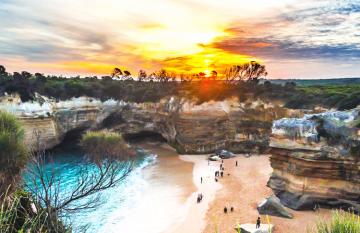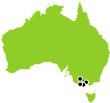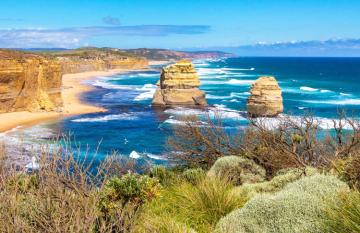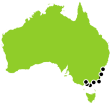
A winding wonderland of craggy cliffs, breathtaking bays and gorgeous beaches, the Great Ocean Road is one of Australia’s best attractions. If you’re looking for everything you need to know about visiting the Great Ocean Road, then you’ve found it.
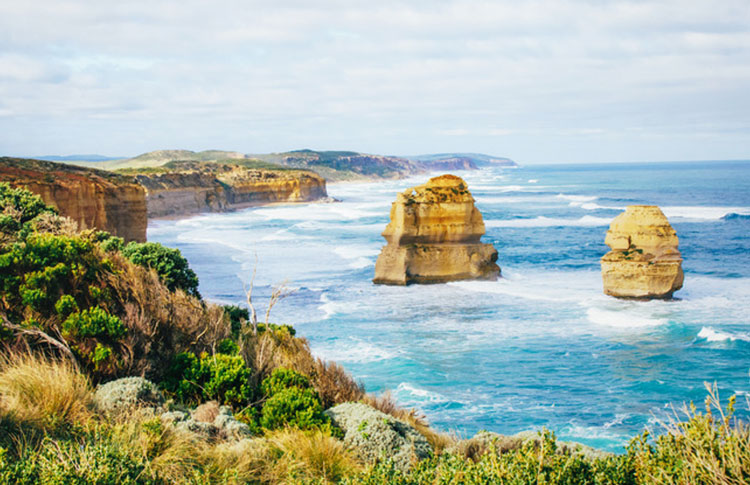
Contents
So, let’s dive in and start exploring...
What is the Great Ocean Road?
The Great Ocean Road is a scenic coastal highway and road following the Southern Ocean around southwestern Victoria towards the border with South Australia. Beginning at the mouth of Port Phillip Bay it takes in stunning surf beaches, eye-catching land formations, lush forests, and rich wildlife areas.
Fun facts and history of the Great Ocean Road
The 243km-long Great Ocean Road was built between 1919-1932 by returned soldiers from the First World War: some claim it to be the world’s largest war memorial.
The Great Ocean Road is also home to some of Australia’s best-known dinosaurs. The rugged, remote cliffs of so-called ‘Dinosaur Cove’ around Cape Otway are an important fossil-bearing in Australia and the wider Southern Hemisphere.
There’s a bit of confusion over where exactly the Great Ocean Road ends. Officially, it runs from Torquay to the town of Allansford, just before Warrnambool. However, most people include Port Fairy, on the other side of Warrnambool, and Portland – further around on Cape Nelson – as key Great Ocean Road destinations. Some say it continues all the way to the South Australian border at Nelson.
So now we know where it is, how do you get there?
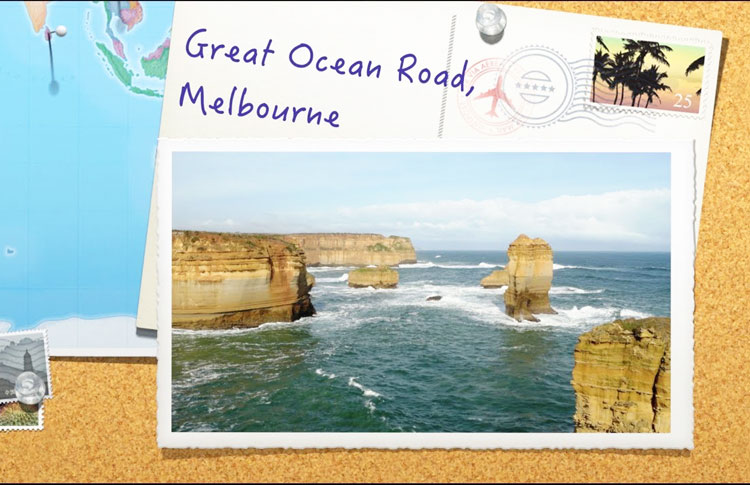
Getting to the Great Ocean Road
Getting to the Great Ocean Road (Eastern End) from Melbourne
The Great Ocean Road begins in Torquay, 80km southwest of Melbourne. It’s around 45 minutes from Melbourne Avalon Airport (AVV) and just over an hour’s drive from central Melbourne, or a 1.5-hour train and bus journey, via Geelong.
By car – It should take around 1 hour and 20 minutes from central Melbourne. Take the M1 freeway out of the city until past Geelong, then veer left at the roundabout near Warum Ponds and follow the signs for Torquay via Coombes Road and Messmate Road.
By public transport – The V-Line train runs 4 times a day from Melbourne’s Southern Cross Station to Geelong Station. From here, bus number 51 or 101 runs towards Torquay Holiday Resort/Surf Coast Highway, every hour throughout the day.
But what if you would rather travel the Great Ocean Road in the other direction, ending up in Melbourne?
Getting to the Great Ocean Road (Western End) from Melbourne
In the west, the closest city to the Great Ocean Road is Warrnambool, just 10km from the official terminus of the Great Ocean Road at Allansford, and 90 minutes (100km) from the coastal town of Portland.
Insider tip: cut your travel time with the Princes Highway
To save time, rather than driving the Great Ocean Road from Melbourne and then back-tracking on yourself driving back to the city, you can instead take the train or drive straight down the inland road (the Princes Highway) to Warrnambool in about 3-4 hours.
Then you can drive the 7-hour scenic route (the Great Ocean Road) on your way back!
Hertz, Avis, and other car hire companies operate out of Warrnambool.
Getting to the Great Ocean Road (Western End) from Adelaide
Plenty of tour operators provide Great Ocean Road tour options from Adelaide – but bear in mind that it adds significant travel time, as the drive from Adelaide to Portland, Port Fairy, or Warrnambool takes somewhere between 6-7 hours.
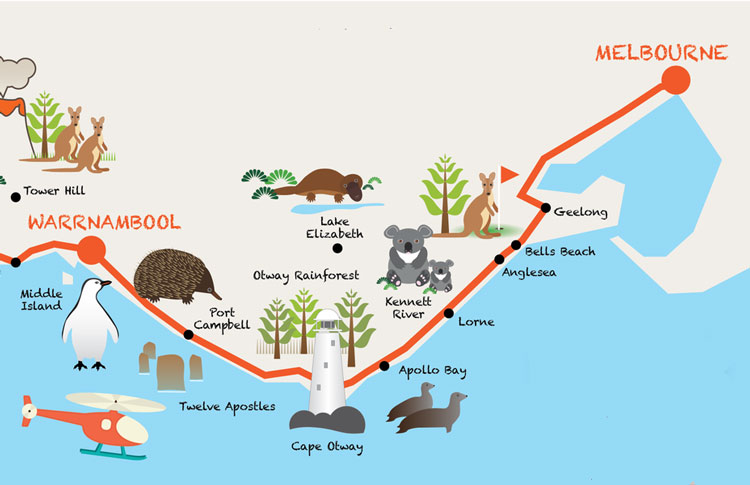
Travelling around on the Great Ocean Road
Once you hit the Great Ocean Road, here’s how you can get about:
By bike – It is possible to get around the Great Ocean Road by bike. You can hire bikes in many small towns such as Port Campbell, Port Fairy, and Anglesea.
Cycling is a great option if you’re hoping to explore the fabulous forest trails (like the mountain biking trails surrounding the aptly-named village of Forrest) or popular rail trails between Warrnambool and Port Fairy (37km), or Camperdown to Timboon (34km).
However, cycling isn’t the most pleasant way to get from town to town along the Great Ocean Road. The roads are narrow, and traffic is often whizzing by at up to 100km/h!
If that doesn’t appeal, it’s best to get in a vehicle:
By car – By far the easiest way to visit the Great Ocean Road is by car.
You could rent a vehicle in a major city like Melbourne or Geelong, with a range of major rental companies like Avis, Budget and Thrifty operating in each. Alternatively, there are a few smaller car hire companies in Torquay.
Driving will give you the ultimate freedom to pick and choose which attractions and destinations you want to see, and to spend as much time as you like in each.
>>If you like the sound of driving yourself around, read on for our suggested Great Ocean Road self-drive itineraries, which range from a few hours to multiple days.
What if you don’t want to drive?
Although hiring a car and driving is a great way to get around the Great Ocean Road, the road is two lanes the entire way, and it can get narrow and winding in parts. So, if you’re not a confident driver, then going by bus may be a better option:
By public bus – There is a public bus that runs the entire length of the Great Ocean Road from Melbourne to Warrnambool via Geelong 3 times a week. Some of the Great Ocean Road’s best coastal towns are included on this bus route, including Apollo Bay, Lorne, and Anglesey.
This is a good, cheap option If you just want to take in some stunning Great Ocean Road scenery out from the bus windows. However, it takes 11 hours total and it has extremely limited sight-seeing time along the way. So unless you are really strapped for time, then there are more rewarding options.
Insider tip for bus travel: Focus on one section of the Great Ocean Road in depth.
Take the Melbourne-Warrnambool bus to one of the coastal towns along the way, and get the bus back to Melbourne a few days later.
By coach tour or private tour – There are dozens of Great Ocean Road tour companies, each offering a range of tours. From bespoke one-on-one private tours where you dictate the itinerary, to budget-friendly small-group minivan tours there’s plenty to choose from.
All of these tour options make sure to include as many top sights as possible, with a bit of leeway for individual preferences – for example:
Echidna Walkabout’s 3-day nature tour is a great one for anybody prioritising wildlife-watching on the Great Ocean Road
Autopia Tours run a unique boutique chocolate and sunset tour
Great Ocean Road Surf Tours can organise multi-day guided trips for anybody wanting to catch some waves along this famous stretch of coast.
But before we get too far ahead of ourselves on how to travel along the Great Ocean Road, let’s dive into what we’ll actually be doing along the way...
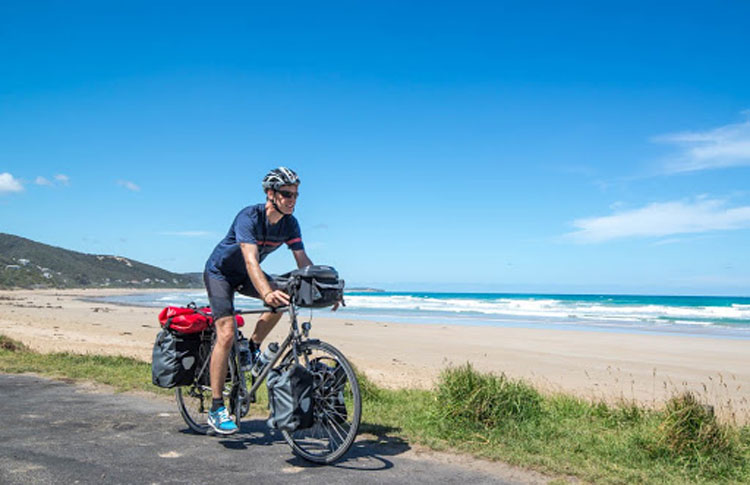
The best things to see on the Great Ocean Road
Don’t miss – the Great Ocean Road must-do’s:
The Shipwreck Coast & Twelve Apostles
Pristine scenery and national parks
Koalas and wildlife spotting
Quaint coastal towns
There’s a huge range of activities to enjoy along the Great Ocean Road, from active outdoor adventures to old-fashioned sight-seeing.
The Shipwreck Coast & Twelve Apostles
The Great Ocean Road is lined with famous photographic backdrops, from surreal rock formations to historic lighthouses.
A lot of the most famous sights are concentrated, however, on the eastern end of 130km-long Shipwreck Coast, where over 600 19th-century shipwrecks gave the area its name.
Since that time, the Shipwreck Coast has become better known for housing the limestone rock formations that comprise the Great Ocean Road’s most famous photo opportunities. Namely...
The Twelve Apostles – These seven (there were eight until 2005) eye-catching limestone stacks are the jewel in the Great Ocean Road’s crown. The ocean panorama from the viewing platform is stunning enough in itself, but the eroded limestone towers sitting 150ft (50m) high in the water make it a unique and unforgettable setting.
London Arch – Formerly known as London Bridge (until the connecting span collapsed in 1990), this impressive off-shore arch formation is long and flat, displaying clearly the layers of sediment and erosion typical of the area. It bears a remarkable structural resemblance to many low, flat bridges that have spanned the River Thames over time.
The Loch Ard Gorge – Named in honour of a tragic shipwreck on nearby Muttonbird Island, this secluded beach has even more natural beauty than it does harrowing history. Ensconced by high limestone cliffs, the Loch Ard Gorge has pristine turquoise water and a kind of lagoon feel. This is a huge contrast to the ferocious waves that batter the outer beaches and occasionally come thundering through the gorge’s narrow entrance.
The Bay of Islands – Further along the coast than its famous cousins, the Bay of Islands gives an incredible vantage point over the coast, ocean, and cliffs from its hilltop lookouts – especially onto the marooned limestone stacks that sit several hundred metres directly out to sea. These offer a point of difference from the land-hugging Twelve Apostles and other nearby limestone structures.
Festivals and annual events on the Great Ocean Road
Be sure to check out the event calendar for when you’ll be in town, because the Great Ocean Road plays host to some of Victoria’s coolest annual festivals.
The prestigious Rip Curl Pro World Surf League (WSL) World Tour event takes place at Bells Beach near Torquay every Easter. It is arguably the most famous surfing event in the world, with the very best of the best vying to ring the famous winner’s bell!
In terms of music, it’s hard to beat Falls Festival in Lorne. The world’s hottest music acts come to town to entertain the youth, who swarm to the coast around New Year and early January.
For more of a family-picnic vibe, the Port Fairy Folk Festival attracts bluegrass, blues, and folk musicians from overseas to historic Port Fairy. Expect four days of amazing performances, themed concerts, and family events in conjunction with a writing festival each March.
Visiting foodies won’t want to miss the fantastic Apollo Bay Seafood Festival in February. This is when local fishers and chefs dish up world-class, locally-caught seafood to crowds of people who flock to the town’s usually sleepy harbourfront and main street. There’s also plenty of music and kids programmes throughout the day.
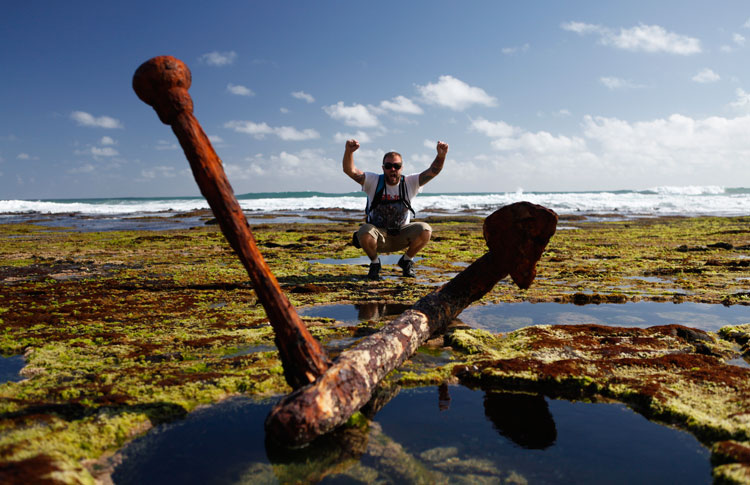
Wildlife spotting on the Great Ocean Road
The Great Ocean Road is home to plenty of furry friends and lovable sea creatures. You’re guaranteed to have an unforgettable wildlife encounter at the following spots:
Kangaroos are par for the course in Anglesea
Grazing ‘roos are a standard sight for golfers on the Anglesea golf course, where around 300 resident kangaroos roam freely around the fairways. On some days it’s easier to spot them than others, as it will depend on weather and the number of people about. But you can book a 30-60 minute kangaroo tour from the clubhouse (in golf carts fitting up to 5 adults). Don’t be shy to say hello if you are just playing a round, the marsupials here are well used to human interaction and you can approach them relatively safely!
Insider tip – if you can’t make it to Anglesea, you can easily spot kangaroos at Tower Hill Wildlife Sanctuary.
Koalas at Kennett River are terrible at hiding
Spotting koalas at Kennett River is like playing hide-and-seek with a two-year-old: you know exactly where they will be before you even start looking for them.
Local tour guides know pretty much which trees you’ll find koalas in at any time of day. But even if you’re doing it on your own, you’re guaranteed to spot at least one koala in the trees if you get off the Great Ocean Road at Kennett River township. Turn onto Grey River Road, then follow the road up through the bush (woodland). You can do this on foot if you like, or drive as far as you like and then find a place to park.
This is one of the most popular spots in Australia for spotting koalas (with good reason), so if it’s too busy you can backtrack. Head back through Kennett River township towards Kennett Road and Hitchcock Gully, where you might be lucky and spot a few less attention-seeking koalas.
Insider tip – if you want to see the koalas a little more active than during their daytime snoozes, visit in the late afternoon and early evening. You might catch one or two grooming themselves, chomping on leaves, or moving from tree to tree scoping out a new spot!
Watch the whales from Logans Beach
Few places in the world can boast such a majestic wildlife encounter just by walking to the beach as Logans Beach can. Just outside Warrnambool, this quiet sandy beach is home to the Victorian Southern Right Whale Nursery. Female whales return here between June and September to give birth and rear their young. Since they are still finding their fins and avoiding the open ocean, these whales will often pass within 100m of the shore! So, rather than having to book a boat tour and head out on whale-watching cruises like in many other places, you can simply spot whales from the beach, or from the specially constructed viewing platform over the dunes.
Aren’t you forgetting our furry (seal) friends?
Don’t worry – if you’re craving a fur seal fix while on the Great Ocean Road, head to Cape Bridgewater to see fur seals up close. Or visit the Southern Hemisphere’s largest colony of Australian fur seals at Lady Julia Percy Island.
National Parks and wildlife walks on the Great Ocean Road
Twisting through some of Victoria’s most pristine scenery, it should come as no surprise that the Great Ocean Road is the access point to some superb protected areas of natural beauty, gorgeous bush walks, and native wildlife refuges. Among them:
Great Otway National Park
The best known national park on the Great Ocean Road, Great Otway National Park does not disappoint with landscapes covering rugged coastal cliffs, idyllic beaches, dense temperate rainforest, cascading waterfalls, and the peaks of the Otway Ranges. Start the lengthy Great Ocean Walk from here towards the Twelve Apostles, visit the iconic Cape Otway Lighthouse, walk the 1-hour loop track up to the Triplet Falls, stroll the boardwalks through the bush at MaitsRest, enjoy a picnic at Blanket Leaf or Moggs Creek, or tackle one of the many, many other waterfall walks throughout the park.
Port Campbell National Park
Encompassing 1,750 hectares of protected nature, the Port Campbell National Park holds a lot more beyond its world-famous Twelve Apostles and other Shipwreck Cove landmarks. Walk the 1.5-hour Port Campbell Discovery Walk for amazing coastal views, wildlife watching opportunities, and clifftop views onto the sleepy settlement that gives the park its name, spot Little Penguins on the beach as they return to their nests at dusk, or camp out at Port Campbell Recreational Reserve.
Marengo Reefs Marine Sanctuary
Located just outside Apollo Bay near the sandy beach at Marengo, the Marengo Reefs Marine Sanctuary is an essential addition to any Great Ocean Road itinerary for lovers of marine life. Explore the rocky beach and the accessible parts of the inner and outer Little Henty Reef see tidal rock pools and reefs teeming with life – invertebrates, seaweed gardens, soft corals, sponge gardens, kelp forests and sea urchins are among the many species that live here. The beach is also great for families, with no end of sealife-spotting ways to entertain curious children!
Discovery Bay Coastal Park
For those planning to venture a bit further along the Great Ocean Road, the remote Discovery Bay Coastal Park offers prime camping and nature opportunities stretching up from Cape Nelson towards the border with South Australia. See long stretches of sandy beaches, rolling sand dunes and dramatic coastal cliffs, most of which you’ll likely have to yourselves, or head inland and visit the rich natural wetlands and freshwater lakes that are home to a diverse habitat of local wildlife and vegetation.
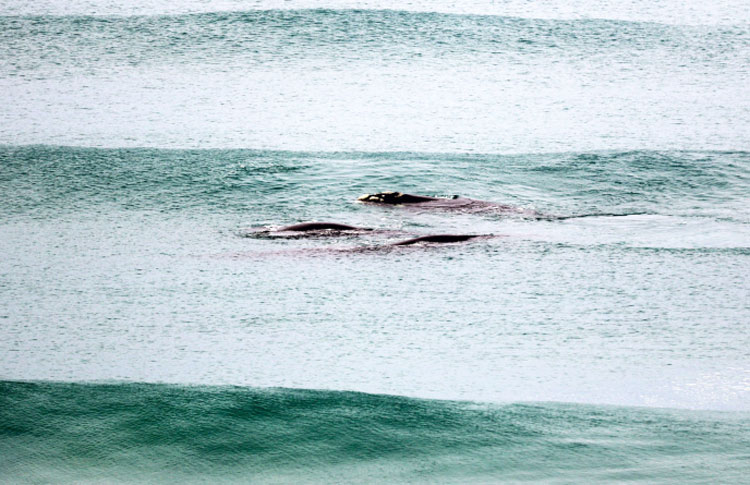
The best Great Ocean Road towns to visit
In addition to outstanding nature and landscapes, the Great Ocean Road is also full of charming small towns and villages with their own individual flavour:
Lorne – best-known for hosting the Falls music festival, Lorne no longer feels like a sleepy seaside town when it swells during peak summer. However, the quirky craft fairs, booming cafe culture, and world-class performers it attracts make up for it.
Apollo Bay – the undoubted seafood capital of the Great Ocean Road, Apollo Bay is an authentic Victorian fishing town with cute houses. It has a beautiful but laid-back beach and incredible national park waterfall walks on its back doorstep.
Port Campbell – the Gateway to the Twelve Apostles is a small village, but it packs a big punch with a huddle of cafes, bars and eateries surrounding a stunning little beach.
- Torquay – although most visitors to the Great Ocean Road simply pass through Torquay, the starting point of the GOR is worth hanging around in – especially for keen surfers. A stone’s throw from world-renowned breaks at Bells Beach and Jan Juc Beach, Torquay is arguably the home of Australian surfing (just don’t mention that to anybody in New South Wales), with the Australian National Surf Museum in town, the Surf Coast Highway and Walk just nearby, and major global surf brands Quiksilver and Rip Curl were both founded here in the 1960s.
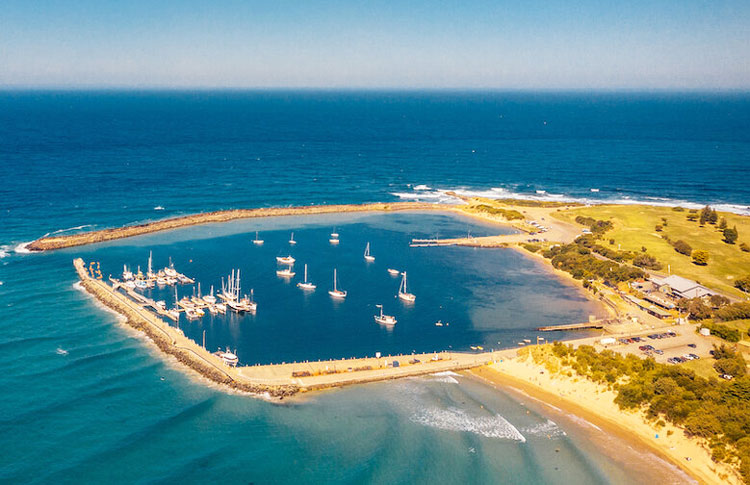
Suggested self-drive itineraries for the Great Ocean Road
With about 400km of road and countless attractions to play with, there’s basically no end to how many different Great Ocean Road driving itineraries you can create. But here are a few samples to give you an idea:
1 day Great Ocean Road self-drive itinerary
Melbourne > Twelve Apostles (3hr 23m, 227.5km) > Port Campbell (10 minutes, 11km) > Lorne (2hr 40m, 160km) > Melbourne (2 hours, 140km)
It’s a big day of driving, but if you want to sample the sights of the Great Ocean Road in one go, it is possible:
7:00 a.m. - 1:00 p.m.
From Melbourne, head straight to the Twelve Apostles via the inland route.
Head southwest out of the city onto the M1 to Geelong. Hook right onto the Princes Highway (A1) until you pass through Colac, then turn left onto the Timboon-Colac Road and follow signs to the Twelve Apostles Visitor Centre. Wander around, take some photos, and then drive on to the beautiful Loch Ard Gorge.
Next, head into quirky Port Campbell for a look around and pick up some fish and chips for lunch from one of the takeaway joints. Eat them on the beach, the public park at the foreshore, or even at the old jetty – the views are unbeatable!
1:00 p.m. - 6:00 p.m.
After lunch, drive east through the gorgeous Cape Otway National Park to Lorne
This takes at least 2.5 hours of driving time, so keep an eye on the time. The Cape Otway Lighthouse is definitely worth the extra 30 minutes or so (coming from the Twelve Apostles, keep an eye out on the LEFT-hand side for the turnoff to the RIGHT onto Lighthouse Road. It’s a windy stretch of road and with cars built up behind you or in a line of traffic, it’s easy to miss – but luckily there is a nice wide stopping bay on the left, so you can safely pull over and wait for any traffic to die down before turning right).
After reaching Lorne in the late afternoon, why not hit the beach, stroll through the ancient eucalyptus gum forests or walk to Erskine Falls. Enjoy a coffee or an evening drink (of the non-alcoholic variety for at least one dedicated driving group member) at one of the establishments lining Lorne’s buzzing main drag.
Whenever you’re ready, it’s just a 2-hour drive back to Melbourne via Torquay and Geelong travelling along the B100 (GOR) and the M1.
next: multi-day itineraries for the Great Ocean Road
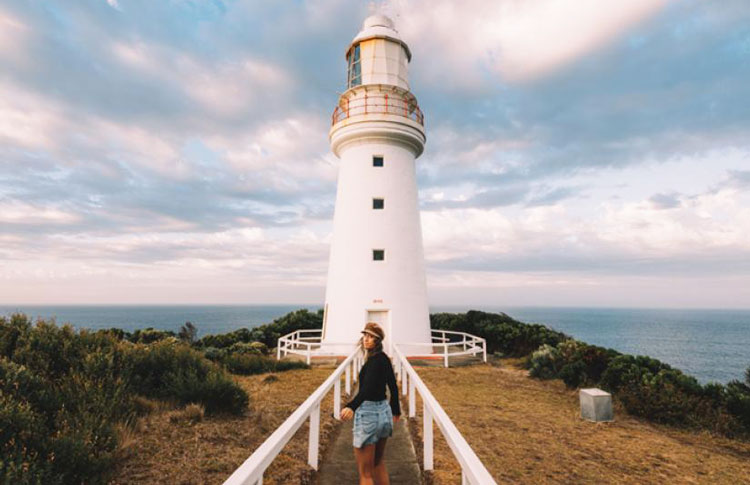
2-4 day Great Ocean Road self-drive itineraries
Use the same route as the 1-day itinerary, but extend it to longer layovers in each place.
For starters, you can dedicate at least an entire day (if not more) to exploring the eastern end of the Shipwreck Coast. You’d get a decent look at not just the Twelve Apostles but also the Loch Ard Gorge, the Grotto, London Bridge, and the Bay of Islands. Not to mention the many other natural limestone formations and historical sites lining this 30km stretch of coastline between Princetown and Peterborough.
5 days+ Great Ocean Road self-drive itineraries
If you set aside at least 5 days to explore the Great Ocean Road by car, then you really have no end of possibilities. Extend the above itinerary west to the official end of the Great Ocean Road at Allansford (40km from Peterborough), then continue onto visit beautiful Port Fairy and the magnificent area around Portland and Cape Nelson (1 hour 30 minutes, 120km from Allansford and Warrnambool).
But where do you sleep?
In terms of towns to spend the night on multi-day Great Ocean Road trips, Apollo Bay, Port Campbell, Port Fairy and Portland make perfect sense.
Cape Otway’s cabins and the camping options around Peterborough, or a farmstay near Portland on Cape Nelson, are good options for a more rural experience if you make it that far.
Up next: Adding the Great Ocean Road to a Longer Australia Itinerary
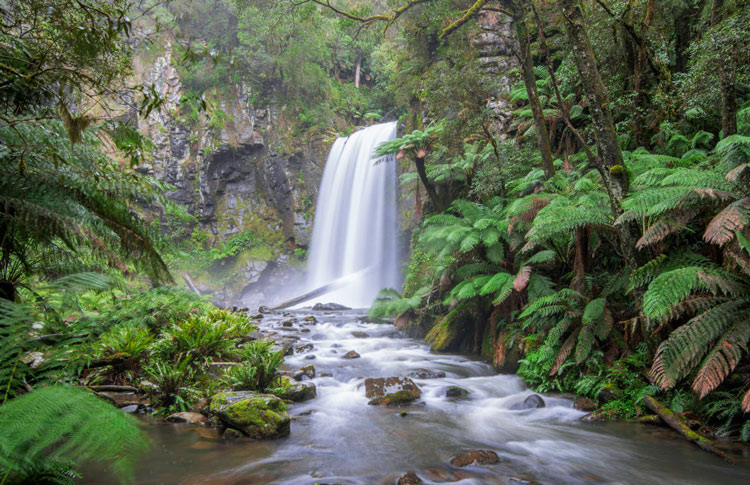
Add the Great Ocean Road to a larger itinerary
If you’re coming from overseas, you are probably visiting other parts of Australia during your trip. So how does the Great Ocean Road fit into a wider itinerary?
Here are a few ideas from our Itinerary Library, dreamed up by First Light Travel’s very own Travel Specialists:
Final word: how to plan a visit to the Great Ocean Road
So, there we have it. It’s a lot to take in, we know – but that’s because there’s a lot to take in on the Great Ocean Road!
To sum up what you need to know when planning a trip to the Great Ocean Road, here’s a recap of what we’ve covered:
What and where the Great Ocean Road is – it’s a scenic coastal roadway that stretches for several hundred kilometres from Torquay to Portland in southern Victoria.
How to get to and around the Great Ocean Road – it’s only an hour or so from Melbourne to Torquay by train, bus or car, but having a car is the best option for getting around and having the freedom to explore more of the Great Ocean Road.
What to do on the Great Ocean Road – whether surfing, forest walks, sight-seeing, shopping, or attending an event, the Great Ocean Road holds endless activity options.
How much time to spend on the Great Ocean Road – depending on how long you have and what you want to see, you can drive all the way to Portland over a week, or shoot down from Melbourne to the Twelve Apostles in half a day.
Next steps? Start planning.
Have a look at the First Light Travel page dedicated to Victorian Self Drive Itineraries.
There are plenty of options to choose from. Or, feel free to jump on the phone (or chat online) with FLT’s friendly staff and create your own customised trip.
Recent Posts
Blog Categories
Blog archives
- April 2024 (1)
- March 2024 (13)
- February 2024 (3)
- January 2024 (5)
- December 2023 (6)
- November 2023 (4)
- October 2023 (11)
- September 2023 (2)
- August 2023 (6)
- July 2023 (2)
- June 2023 (17)
- May 2023 (3)
- April 2023 (5)
- March 2023 (8)
- February 2023 (9)
- January 2023 (12)
- December 2022 (9)
- November 2022 (12)
- October 2022 (12)
- September 2022 (12)
- August 2022 (6)
- July 2022 (9)
- June 2022 (7)
- May 2022 (3)
- April 2022 (4)
- March 2022 (6)
- February 2022 (1)
- January 2022 (4)
- December 2021 (2)
- November 2021 (3)
- October 2021 (1)
- September 2021 (4)
- August 2021 (10)
- July 2021 (13)
- June 2021 (6)
- April 2021 (2)
- March 2021 (2)
- February 2021 (1)
- January 2021 (1)
- December 2020 (2)
- November 2020 (3)
- October 2020 (2)
- September 2020 (1)
- August 2020 (1)
- July 2020 (1)
- June 2020 (1)
- May 2020 (1)
- April 2020 (1)
- March 2020 (1)
- February 2020 (2)
- January 2020 (4)
- December 2019 (2)
- November 2019 (1)
- October 2019 (1)
- September 2019 (5)
- August 2019 (1)
- July 2019 (5)
- June 2019 (1)
- May 2019 (1)
- April 2019 (1)
- March 2019 (1)
- February 2019 (1)
- January 2019 (1)
- December 2018 (1)
- October 2018 (1)
- May 2018 (1)
- February 2018 (1)
- December 2017 (1)
- October 2017 (1)
- June 2017 (1)
- May 2017 (1)
- February 2017 (1)
- January 2017 (1)
- September 2016 (1)
- August 2016 (2)
- July 2016 (1)
- June 2016 (1)
- May 2016 (1)
- April 2016 (1)
- December 2015 (1)




